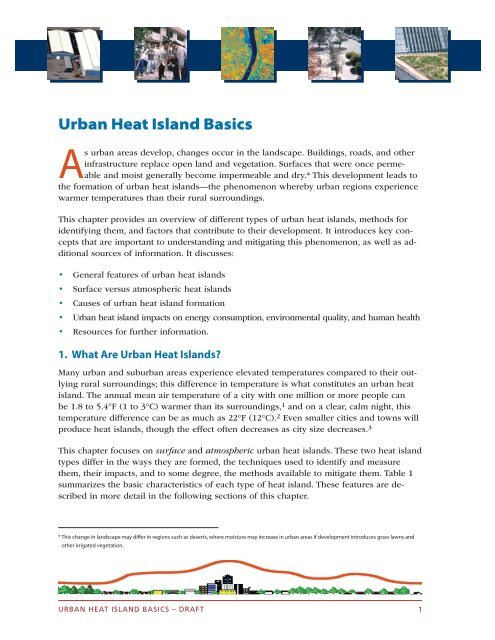Urban Heat Island Basics - US Environmental Protection Agency
Urban Heat Island Basics - US Environmental Protection Agency
Urban Heat Island Basics - US Environmental Protection Agency
You also want an ePaper? Increase the reach of your titles
YUMPU automatically turns print PDFs into web optimized ePapers that Google loves.
<strong>Urban</strong> <strong>Heat</strong> <strong>Island</strong> <strong>Basics</strong><br />
As urban areas develop, changes occur in the landscape. Buildings, roads, and other<br />
infrastructure replace open land and vegetation. Surfaces that were once permeable<br />
and moist generally become impermeable and dry.* This development leads to<br />
the formation of urban heat islands—the phenomenon whereby urban regions experience<br />
warmer temperatures than their rural surroundings.<br />
This chapter provides an overview of different types of urban heat islands, methods for<br />
identifying them, and factors that contribute to their development. It introduces key concepts<br />
that are important to understanding and mitigating this phenomenon, as well as additional<br />
sources of information. It discusses:<br />
•<br />
•<br />
•<br />
•<br />
•<br />
General features of urban heat islands<br />
Surface versus atmospheric heat islands<br />
Causes of urban heat island formation<br />
<strong>Urban</strong> heat island impacts on energy consumption, environmental quality, and human health<br />
Resources for further information.<br />
1 . What Are <strong>Urban</strong> <strong>Heat</strong> <strong>Island</strong>s?<br />
Many urban and suburban areas experience elevated temperatures compared to their outlying<br />
rural surroundings; this difference in temperature is what constitutes an urban heat<br />
island. The annual mean air temperature of a city with one million or more people can<br />
be 1.8 to 5.4°F (1 to 3°C) warmer than its surroundings, 1 and on a clear, calm night, this<br />
temperature difference can be as much as 22°F (12°C). 2 Even smaller cities and towns will<br />
produce heat islands, though the effect often decreases as city size decreases. 3<br />
This chapter focuses on surface and atmospheric urban heat islands. These two heat island<br />
types differ in the ways they are formed, the techniques used to identify and measure<br />
them, their impacts, and to some degree, the methods available to mitigate them. Table 1<br />
summarizes the basic characteristics of each type of heat island. These features are described<br />
in more detail in the following sections of this chapter.<br />
* This change in landscape may differ in regions such as deserts, where moisture may increase in urban areas if development introduces grass lawns and<br />
other irrigated vegetation.<br />
URBAN HeAt IslANd BAsIcs – dRAFt 1

















